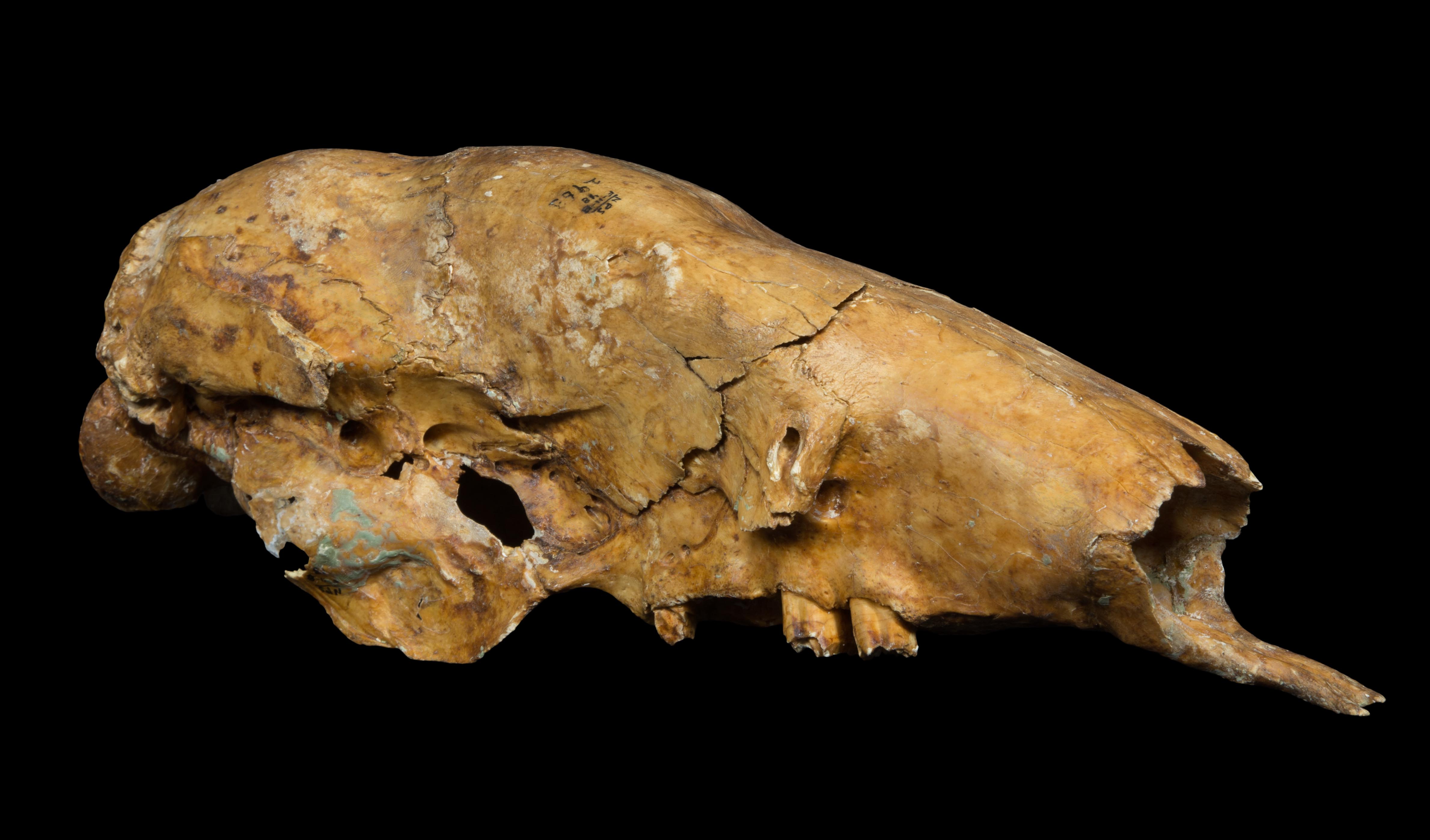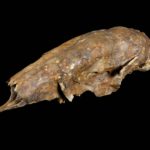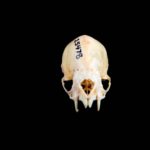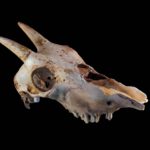Rampart Cave, located near the western end of the Grand Canyon, once contained one of the most impressive deposits of Pleistocene mammal remains, including bones, skin and hair, and dung known in North America. Discovered in 1936, the cave was subject of several major research projects until 1976, when an estimated two-thirds of the cave deposits were lost to a months-long fire most likely set by campers or vandals.
Prior to the fire, the dung—mostly from Shasta ground sloths (Nothrotheriops shastensis)—had accumulated to a depth of 20 feet in places and represented two long periods of use, one between 40,000 and 24,000 years ago, and one between 13,000 and 11,000 years ago.
Shasta ground sloth were around the size of a modern grizzly bear—roughly 9 feet long and weighing more than 500 lbs—and were herbivorous. Studies of the dung show the sloths ate a variety of desert plants, including globemallow, Mormon tea, saltbush, catclaw, cacti, reeds, and yucca.
Found in the cave deposits were also sloth bones, skin, and hair, and well as the skeletal remains of other extinct Pleistocene mammals, including Harrington’s mountain goat (Oreomnos harringtoni), North American horse (Equus sp.), and a species of vampire bat (Desmodus stocki).
3D models are available for the Shasta ground sloth skull and dung, and for the Harrington’s mountain goat skull, and additional images, including the sloth skin and hair, are available in the galleries below.
Image galleries
- Ground Sloth
- Vampire Bat
- Mountain Goat
Rampart Cave species
| Common Name | Scientific Name | Extinct? |
|---|---|---|
| Mammals | ||
| American porcupine | Erethizon dorsata | |
| Bighorn sheep | Ovis canadensis | |
| Bobcat | Lynx sp. | |
| Brazilian free-tailed bat | Tadarida brasiliensis | |
| Chipmunks | Eutamias sp. | |
| Cottontail | Sylvilagus sp. | |
| Deer mice | Peromyscus sp. | |
| Harrington's mountain goat | Oreamnos harringtoni | x |
| Jackrabbit | Lepus sp. | |
| Kangaroo rats | Dipodomys sp. | |
| Mastiff bats | Eumops sp. | |
| Mountain Lion | Puma concolor | |
| North American horse | Equus sp. | x |
| Ringtail | Bassariscus astutus | |
| Shasta ground sloth | Northrotheriops shastensis | x |
| Skunk | Spilogale sp. | |
| Spermophile ground squirrels | Spermophilus sp. | |
| Stock's vampire bat | Desmodus stocki | x |
| Weasels | Mustela sp. | |
| Western pocket gophers | Thomomys sp. | |
| Woodrats/Packrats | Neotoma sp. | |
| Yellow-bellied marmot | Marmota flaviventris | |
| Birds | ||
| Aplomado falcon | Falco femoralis | |
| Barn owl | Tyto alba | |
| Black vulture | Coragyps atratus | |
| Black-crowned night-heron | Nycticorax nycticorax | |
| California condor | Gymnogyps californianus | |
| Golden eagle | Aquila chryaetos | |
| Red-tail hawk | Buteo jamaicensis | |
| Turkey vulture | Cathartes aura | |
| Western vulture | Coragyps occidentalis | x |
| Reptiles | ||
| Morafka's desert tortoise | Gopherus morafkai | |
| Chuckwalla | Sauromalus ater | |
| Desert spiny lizard | Sceloporus magister | |
| Gopher snake | Pituophis catenifer | |
| Long-nosed snake | Rhinocheilus lecontei | |
| Northern plateau lizard | Sceloporus tristichus | |
| Parasites (from sloth dung) | ||
| Juvenile, pinworm-like | Agamofilaria oxyura | x |
| Protozoan | Archeococcidia antiquus | x |
| Protozoan | Archeococcidia nothrotheriopae | x |
| Roundworm | Strongyloides shastensis | x |
| Plants (from sloth dung) | ||
| Cacti | Opuntia sp. | |
| Catclaw acacia | Acacia greggii | |
| Common reed | Phragmites communis | |
| Desert globemallow | Sphaeralcea ambigua | |
| Nevada Mormon tea | Ephedra nevadensis | |
| Saltbush | Atriplex sp. | |
| Yucca | Yucca sp. | |
| Plants (from packrat middens) | ||
| Banana yucca | Yucca baccata | |
| Beargrass | Nolina microcarpa | |
| Beavertail cactus | Optunia basilaris | |
| Birchlead buckthorn | Rhamnus betaefolia | |
| Blackbrush | Coleogyne ramosissima | |
| Brittlebrush | Encelia farinosa | |
| Catclaw acacia | Acacia greggii | |
| Desert almond | Prunus fasciculata | |
| Globemallow | Sphaeralcea sp. | |
| Ground cherry | Physalis sp. | |
| Juniper | Juniperus sp. | |
| Knowlton hophornbeam | Ostrya knowltonii | |
| Little-leaf mountain mahogany | Cercocarpus intricatus | |
| Mormon tea | Ephedra sp. | |
| Rabbitbush | Chrysothamnus sp. | |
| Single-leaf ash | Fraxinus anomala | |
| Snowberry | Symphoricarpos sp. | |
| Squawbush | Rhus trilobata | |
| Shadscale | Atriplex confertifolia | |
| Utah agave | Agave utahensis | |
| Whipple cholla | Optunia whipplei | |
| Wooly-headed barrel cactus | Echinocactus polyephalus |
Species list derived from:
Carpenter, Mary C. (2003) Late Pleistocene Aves, Chiroptera, Perissodactyla, and Artiodactyla from Rampart Cave, Grand Canyon, Arizona. Master’s Thesis, University of Northern Arizona, Flagstaff.
Hansen, Richard M. (1978) Shasta Ground Sloth Food Habits, Rampart Cave, Arizona. Paleobiology 4(3):302-319.
Kenworthy, J., V. L. Santucci, and K. L. Cole (2004) An Inventory of Paleontological Resources Associated with Caves in Grand Canyon National Park. In The Colorado Plateau, Cultural, Biological, and Physical Research, edited by C.V. Riper III and K.L. Cole, pp. 211-228. University of Arizona Press, Tucson.
Lindsay, E. H., and N. T. Tessman (1974) Late Cenozoic Vertebrate Localities and Faunas in Arizona. Journal of the Arizona Academy of Science 9:3-24.
Mead, J. I., N. J. Czaplewski, and L. D. Agenbroad (2005) Rancholabrean (Late Pleistocene) Mammals and Localities of Arizona. In Vertebrate Paleontology of Arizona, edited by R.D. McCord, pp. 139-180. Mesa Southwest Museum Bulletin No. 11.
Miller, L. (1960) Condor Remains from Rampart Cave, Arizona. Condor 62:70.
Phillips, Arthur M., III (1984) Shasta Ground Sloth Extinction: Fossil Packrat Midden Evidence from the Western Grand Canyon. In Quaternary Extinctions: A Prehistoric Revolution, edited by P.S. Martin and R.G. Klein, pp. 148-158. University of Arizona Press.
Schmidt, Gerald D., Donald W. Duszynski, and Paul S. Martin (1992) Parasites of the Extinct Shasta Ground Sloth, Nothrotheriops shastensis, in Rampart Cave, Arizona. Faculty Publications from the Harold W. Manter Laboratory of Parasitology. Paper 181. http://digitalcommons.unl.edu/parasitologyfacpubs/181 (link opens in new window).
Van Devender, T. R., A. M. Phillips, and J. I. Mead (1977) Late Pleistocene Reptiles and Small Mammals from the Lower Grand Canyon of Arizona. Southwestern Naturalist 22:49-66.
Wilson, R. W. (1942) Preliminary Study of the Fauna of Rampart Cave, Arizona. Contributions to Paleontology 6. Carnegie Institute of Washington Publication 530:169-185.
Learn more….(link opens in new window)




